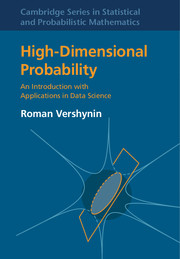'This is an excellent and very timely text, presenting the modern tools of high-dimensional geometry and probability in a very accessible and applications-oriented manner, with plenty of informative exercises. The book is infused with the author's insights and intuition in this field, and has extensive references to the latest developments in the area. This book will be an extremely useful resource both for newcomers to this subject and for expert researchers.'
Terence Tao - University of California, Los Angeles
'Methods of high-dimensional probability have become indispensable in numerous problems of probability theory and its applications in mathematics, statistics, computer science, and electrical engineering. Roman Vershynin's wonderful text fills a major gap in the literature by providing a highly accessible introduction to this area. Starting with no prerequisites beyond a first course in probability and linear algebra, Vershynin takes the reader on a guided tour through the subject and consistently illustrates the utility of the material through modern data science applications. This book should be essential reading for students and researchers in probability theory, data science, and related fields.'
Ramon van Handel - Princeton University, New Jersey
'This very welcome contribution to the literature gives a concise introduction to several topics in ‘high-dimensional probability’ that are of key relevance in contemporary statistical science and machine learning. The author achieves a fine balance between presenting deep theory and maintaining readability for a non-specialist audience - this book is thus highly recommended for graduate students and researchers alike who wish to learn more about this by now indispensable field of modern mathematics.'
Richard Nickl - University of Cambridge
ershynin is one of the world's leading experts in the area of high-dimensional probability, and his textbook provides a gentle yet thorough treatment of many of the key tools in the area and their applications to the field of data science. The topics covered here are a must-know for anyone looking to do mathematical work in the field, covering subjects important in machine learning, algorithms and theoretical computer science, signal processing, and applied mathematics.'
Jelani Nelson - Harvard University, Massachusetts
'High-Dimensional Probability is an excellent treatment of modern methods in probability and data analysis. Vershynin's perspective is unique and insightful, informed by his expertise as both a probabilist and a functional analyst. His treatment of the subject is gentle, thorough and inviting, providing a great resource for both newcomers and those familiar with the subject. I believe, as the author does, that the topics covered in this book are indeed essential ingredients of the developing foundations of data science.'
Santosh Vempala - Georgia Institute of Technology
'Renowned for his deep contributions to high-dimensional probability, Roman Vershynin is to be commended for the clarity of his progressive exposition of the important concepts, tools and techniques of the field. Advanced students and practitioners interested in the mathematical foundations of data science will enjoy the many relevant worked examples and lively use of exercises. This book is the reference I had been waiting for.'
Rémi Gribonval - IEEE and EURASIP Fellow, Directeur de Recherche, Inria, France
'High-dimensional probability is a fascinating mathematical theory that has rapidly grown in recent years. It is fundamental to high-dimensional statistics, machine learning and data science. In this book, Roman Vershynin, who is a leading researcher in high-dimensional probability and a master of exposition, provides the basic tools and some of the main results and applications of high-dimensional probability. This book is an excellent textbook for a graduate course that will be appreciated by mathematics, statistics, computer science, and engineering students. It will also serve as an excellent reference book for researchers working in high-dimensional probability and statistics.'
Elchanan Mossel - Massachusetts Institute of Technology
'This book on the theory and application of high-dimensional probability is a work of exceptional clarity that will be valuable to students and researchers interested in the foundations of data science. A working knowledge of high dimensional probability is essential for researchers at the intersection of applied mathematics, statistics and computer science. The widely accessible presentation will make this book a classic that everyone in foundational data science will want to have on their bookshelf.'
Alfred Hero - University of Michigan
'Vershynin's book is a brilliant introduction to the mathematics which is at the core of modern signal processing and data science. The focus is on concentration of measure and its applications to random matrices, random graphs, dimensionality reduction, and suprema of random process. The treatment is remarkably clean, and the reader will learn beautiful and deep mathematics without unnecessary formalism.'
Andrea Montanari - Stanford University, California
'The ideas presented here have emerged as the essential core of a modern mathematical education, essential not only for probabilists but also for any researcher interested in high-dimensional statistics, the theory of algorithms, information theory, statistical physics and dynamical systems. Moreover, as Vershynin ably demonstrates, mastering these ideas will provide insight into the essential unity underlying these disciplines.'
Michael Jordan - University of California, Berkeley
'The current monograph is a welcome text providing a clear and concise introduction to many recent (and less recent) developments, in which the author played an important role.'
Sasha Sodin
Source: MathsSciNet
'A good textbook is as much about learning as about learning something specific. Vershynin’s High-Dimensional Probability is a good textbook. When developing a topic, it starts from the simplest idea, it examines its weaknesses and builds up to a better idea; this is superbly done when bounding the tail probabilities of binomial distributions in Chapter 2. It always prioritises high-level narrative to technical details; the reader never loses sight of the main theme, arguments are kept to their essence, side results are given as exercises and important special cases are given priority over the most general statements. Intuition is at least as important as the techniques; this is usually the hardest to communicate in a book, compared for example to a classroom presentation, but it comes across beautifully in this book …'
Omiros Papaspiliopoulos
Source: Newsletter of the Bachelier Finance Society



